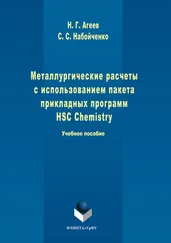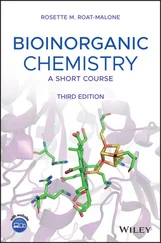1 ...6 7 8 10 11 12 ...15 In many ways, a potentiometry experiment is simpler than a voltammetry experiment. A pH measurement with a glass electrode is a potentiometric experiment. The chemical composition of the sample solution surrounding the indicator electrode establishes an electrical potential energy difference across the boundary between the indicator electrode and the sample solution. The potential that the voltmeter reads is often called the cell potential, E cell. It is common to think about the cell as an assembly of two “half‐cells.” Usually, the electron‐transfer reaction taking place at the reference electrode constitutes one half reaction and the process occurring at the other electrode is the “indicator” half reaction. The measured cell potential represents the difference between the reference and indicator electrode potentials.
(1.14) 
In practice E referenceis a well‐known constant so that any changes in the measured voltage for the cell can be interpreted as changes at the indicator electrode.
Voltammetry experiments, where currents are measured, require ions in the solution to carry charge between electrodes. Even though water ionizes to a small degree (for pure water [H +] = [OH −] = 10 −7M), the conductance of water is usually too small for the purposes of most voltammetry experiments. Instead, one usually adds a pure salt to the sample solution. The salt is often referred to as the supporting electrolyte. Because the pH of a solution influences the electrode reaction in many cases, often an acid/base buffer is also included in the supporting electrolyte. The supporting electrolyte keeps the electrical resistance down. Lower resistance helps minimize voltage errors due to “ohmic losses” in voltammetry experiments. In a voltammetry experiment, current passes through the cell. The solution that carries that current has a finite electrical resistance. Energy, in the form of voltage, is lost overcoming the resistance according to Ohm's law. This loss represents an error in the measurement of the true voltage. The energy lost in volts, V , is given by
(1.15) 
where i is the current driven through the solution resistance, R . The actual voltage that reaches the electrode, V actualis
(1.16) 
In typical voltammetry experiments, the resistance is on the order of 100 Ω. Consequently, errors on the order of 1 mV or bigger occur when the current reaches 10 −5A (=10 −3V/100 Ω) or more. The energy lost in overcoming the solution resistance is energy that is not applied to the working electrode. Whenever the product, iR , is greater than a few millivolts, the assumption that all of the energy applied to the cell is focused onto the working electrode/solution interface no longer holds and the data are suspect.
1.3.3 Supporting Electrolyte
Supporting electrolyte is also important in potentiometry experiments, even though the current is virtually zero in those experiments. The reason for that is that all potentiometric indicator electrodes respond to the activity of an analyte, not just its concentration. The activity of an ion is a function of the ionic strength of the solution. Recall that the ionic strength, μ , is a measure of the concentration of charge:
(1.17) 
where c iis the molar concentration of an ion with charge, z i, summed over all ions. In addition to the effect on activity of the analyte, the mismatch between the sample solution and reference solution in concentration and type of ions making up the supporting electrolyte contributes to an error called the liquid junction potential. (That phenomenon is addressed latter in this chapter.) Consequently, it is important to control the ionic strength. This is often done by the addition of a solution of a high concentration of electrolyte, known as an ionic strength adjustment buffer. Whenever that is not practical, an effort is made to keep the ionic strength constant among all the sample and calibration standards. (Ion activities and activity coefficients are discussed in Appendix A.)
A special voltmeter is used to monitor the potential between the electrodes. In order to function, any electronic meter requires some current to flow. As will be discussed later, drawing a significant level of current through the sensor distorts the voltage signal being measured. Therefore, the goal is to minimize the amount of current that is drawn. The type of voltmeter that is typically used in a pH meter or other potentiometric apparatus can measure the voltage while preventing a significant amount of current from flowing in the circuit. This attribute is what makes the meter special. Typical voltmeters sold in hardware stores draw current levels of around 10 −6A. For many electrochemical applications, a level above 10 −12A can be a significant amount of current. Voltmeters used in potentiometry are designed to draw tiny currents (10 −12A or smaller) during operation. They are said to have a high input impedance because they impede the flow of current into the meter.
1.4 The Electrified Interface or Electrical Double Layer
Instrumental methods of electrochemical analysis depend upon chemical events at boundaries between two different phases. In potentiometric experiments, interesting processes give rise to a separation of charge at the boundary between the sample and sensor; in voltammetric experiments an outside power source applies a voltage to the working electrode creating a separation of charge that drives interesting processes there. It is common for charges to appear at many different phase boundaries in nature, for example, at the surface of biological cell walls, on the surface of water droplets or solid aerosols, and at the surface of wet materials such as ceramics, clays, sediments, and soils. The same electrochemical principles that are involved in electrochemical analysis drive lots of natural phenomena as well. One of the most important concepts that is universal is the boundary between two phases where charges accumulate. It is called the electrified interface or the electrical double layer.
1.4.1 Structure of the Double Layer
There are numerous electrochemical sensors that selectively respond to a specific chemical species of interest. For example, fluoride is routinely monitored in municipal drinking water by fluoride selective electrodes. Lithium ion can be determined in the blood or urine of a patient being treated for depression by lithium‐containing medications using a lithium ion selective electrode. These devices are popular because of their simplicity of use and their reliability. The increasing interest in monitoring select chemical species in clinical, environmental, industrial settings and, more recently, in private homes and for personal health monitoring is likely to encourage the development and implementation of even more sensors of this type.
The heart of all electrochemical sensing devices is the boundary between the sensor and the test solution. It is there that a charge separation develops. Because of its importance, it is very useful to take a closer look at the structure of the boundary. Consider, for example, a metal wire dipping into a salt solution. Assume, for the sake of discussion, that an excess of negative charge (i.e. electrons) appears on the wire. Electromagnetic theory predicts that the excess charge will appear at the surface of the metal. The arrangement of charges on the solution side is a bit more complicated. The excess electrons will naturally attract cations from solution. In the mid‐nineteenth century, the German scientist Herman Helmholtz imagined that all of the cations necessary to balance the charge on the metal surface migrate into position at a small distance from the surface forming a plane of charge [5]. It is now known that the cations do not actually come into contact with the metal surface because a monolayer of water molecules cling directly to the surface and are not easily displaced. Furthermore, individual cations are surrounded by a sphere of water molecules, known as the hydration sphere, that are also tightly bound. As a consequence, the cations approach the electrode surface no closer than about a distance equal to the length of two water molecules (about 5–6 Å total). Figure 1.5shows cations with their hydration spheres parked in a line outside a layer of water molecules attached to the electrode surface. The centers of these cations represent a layer now known as the OHP. In the Helmholtz model, the charge on the OHP is equivalent in magnitude to the charge on the metal. This model closely resembles a simple capacitor.
Читать дальше
















